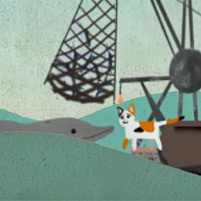Virtual Crowd Pleaser
"The Fisherman's Cat" trailer
"Last Stop on the H Line" trailer

Put it on your bucket list of things to do before you leave Carnegie Mellon University, because the annual Building Virtual Worlds (BVW) Show is a must-see event.
CMU's Entertainment Technology Center recently presented this year's best work by students in the BVW class. The show is open to the public.
Aspiring game designer John Baxa (CMU'14), producer for "The Fisherman's Cat" and "Last Stop on the H Line," says the BVW class helped him discover talent he didn't know he had.
"I used to doodle in sketchbooks, but I never would have called myself an artist before," Baxa said. "In this class, you learn how to work well with others under pressure and also to question your own decision-making."
The BVW class was created by the late computer science professor and CMU alumnus Randy Pausch, who became world famous for his inspirational "Last Lecture" video and book.
Teams of students are assigned to create a new virtual world in a two- to three-week period. At the end of that period, the students rank their teammates on qualities such as leadership, availability and quality of work. Then, they reassemble into new teams and repeat.
Phillip Chung (CMU'14), who animated "Last Stop on the H Line," had heard of Pausch's BVW class as an undergrad at CMU.
"I knew what I was getting into. I knew it was going to be like a boot camp experience," Chung said. "Two weeks is not enough time to make anything well. I really loved working with different people and seeing what kinds of products we could make in that short period of time."
Originally a computer science major, Chung says he wasn't satisfied just doing programming.
"I wanted to blend my experience in technology and my interest in art, and the Entertainment Technology Center (ETC) is the perfect place for that," Chung said. "As the animator on the team, I am able to keep in mind what the programmer can do and can't do. I can also pinch-hit on the more menial tasks, if the programmer needs help."
Baxa loved the team aspect of the course.
"We learned from everybody's different working styles, and by the fifth round, I knew exactly who I wanted to work with. I knew whose work styles enabled me to be the most creative, productive and efficient."
The flip side of that is that Baxa also learned about himself.
"At the end of the course, they do some fancy math and produce a chart with code names attached. Only you know your code name, so you can go to the chart, and see how your classmates ranked you," Baxa explained. "For example, I may find that my classmates ranked me at the top in leadership, but at the bottom in availability. So I would see that availability is something I may need to work on."
Baxa would like to be a game designer, writer or producer. And he says he feels well-prepared for any of those careers after having taken the BVW class.
"It prepares you with the amount of work you have to put out. It teaches you what types of games you're really interested in. And it helps you broaden your portfolio. I didn't have concept art in my portfolio before."
As far as the show, Baxa is ready.
"I like the idea of doing the show and inviting friends, family and industry professionals. It's like a reward for all the hard work you did over the semester," Baxa said.
"It's also nice to celebrate all the work by your classmates. They did an amazing job."
Related Links: Building Virtual Worlds | Pre-College Game Academy | Randy Pausch | Entertainment Technology Center
